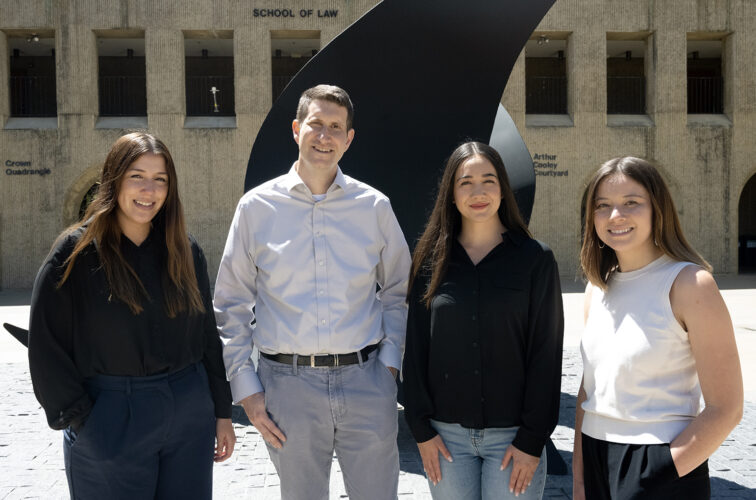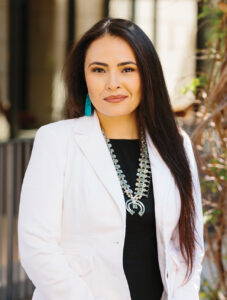NALSA: 50 Years of SLS Native Community

During the 1972-73 school year, in the aftermath of campus debates about Stanford University’s then-mascot, the Indian, a group of Stanford Law School friends joined forces. “There was a handful of Native students at the law school. We all knew each other, liked each other, and figured we should form a group to address Native American issues and provide a bit of extra support,” remembers Jack Manning, JD ’75, one of the founding members of Stanford Law School’s Native American Law Students Association (NALSA).
Fifty years later, NALSA continues to provide support to the law school’s Native students—along with mentorship, retreats, panel discussions, academic resources, and other opportunities for dialogue and friendship. As NALSA moves into its next 50 years, the group’s incoming “tri-presidents”—three Native women law students—have crafted a forward-looking agenda for the organization.
“One of our primary goals is to help the law school attract and retain the country’s most promising Native law students,” says Carson Smith, JD ’25 (BA ’19), a member of the Choctaw Nation of Oklahoma and one of the incoming presidents, along with Makena Kauhane, JD ’25, and Marissa Uri, JD ’25. “If you want to study federal Indian law or tribal law, and you want to be part of a dynamic Native campus community, Stanford is where you need to be.”
Focusing on Community and Today’s Legal Issues
Uri, who is Choctaw-Cherokee, says she’s focused on bringing Indian and tribal law to the forefront of discourse at the law school. “So many of our doctrinal courses as 1Ls discuss Indian law without really discussing it,” she says. “Take property, for example, where we talk about the origination of deeds and titles, but do not discuss how that is deeply intertwined with removing Native communities from Indigenous land. I would love to create more spaces where we can discuss this doctrine accessibly.”

And as it was for the generations before them, community-building remains central. Smith says she relied heavily on the support she received from other NALSA members when she started law school. “When I was looking for advice and support, the people who were there surrounding me, lifting me up, were the people in NALSA, and the professors, who made sure I understood how a final worked, how to pick my next term’s classes, and figure out what I wanted to do for my summer job. Having these deep relationships in this community space really helped me get through that first term, when everything is so new and different from anything else I’d really experienced.”
Founding member Manning, who was raised on the Fort Peck Sioux Reservation in Montana, spent most of his career in Great Falls and Missoula, Montana, as a partner with Dorsey & Whitney, occasionally handling Indian law matters and doing work for the Fort Peck Sioux and other tribes. Decades after he and his friends founded NALSA, Manning’s own daughter, Molly Manning, JD ’17, would be one of the students the group would make feel welcome.
“NALSA was welcoming even before I stepped on campus when several members reached out to congratulate me on my acceptance,” says the younger Manning, an associate in the New York office of Wilson Sonsini. “The support, friendship and mentoring was incredibly valuable during my three years at SLS and has continued as my fellow NALSA members have gone on to our professional careers.”

Meeting Legal Needs of Community
Daniel Ahrens, JD ’23, current NALSA co-president, adds that the support and mentorship given to NALSA by the law school’s two faculty members who are focused on American Indian and Indigenous Law have been important to its continued success. “The leadership of Professors Elizabeth Reese and Greg Ablavsky has been key not just to the strength of NALSA itself, but to inspiring a broad swath of SLS students to study Indian law and work in law school clinics that serve Native people.”
“I think awareness of Native issues at the law school amongst the general student body is likely higher than it has ever been,” continues Ahrens, who, in addition to co-leading NALSA, also co-founded the Stanford Native Law Pro Bono Project. “Federal Indian Law was the most popular course at the law school in the quarter I took it. Tribal Law and the Yurok policy lab are offered every year. We have over 30 students, Native and non-Native, in the pro bono project.”
Current NALSA co-president Madi Burson, JD ’24, adds that the connections inspired by NALSA endure long past graduation. “I know I will continue to lean on folks I met here and that I will stay connected with the students who will come after me.” SL
Read Stanford Lawyer’s feature story: Fighting for the Future of Indian Law
